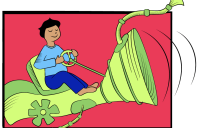by Dani Fitts
San Francisco Fellow ’11
In my time here at San Francisco, the Board of Supervisors has held two hearings entitled “Report of Assessment Costs for Blighted Properties”. During these hearings property owners are given the opportunity to object to fines levied against them for failing to remove blight from their properties. I was confused and intrigued by this hearing and after a little research I discovered Chapter 80 of the San Francisco Administrative Code titled “Anti-Blight Enforcement Procedure.” This ordinance seeks to provide a way for the City to improve the quality of life in San Francisco by establishing a centralized anti-blight enforcement and abatement program. The definition of “blight” in the ordinance is extensive, including everything from dead or decaying trees, weeds, and litter to unpainted buildings, deteriorating or defaced buildings or sections thereof, and items in an outdoor area which are not usually stored outdoors. The abatement program allows the Director of the Department of Public Works (DPW) to fine property owners if they fail to remove blight from their property.
The broad definition of “blight” in the Administrative Code would suggest that property owners could be fined for almost anything, but the overwhelming majority of property owners at these hearings were fined because of graffiti. An interesting argument pitting the arts against the law arose. Several property owners argued that the “graffiti” on their building was, in fact, a beautiful mural painstakingly and lovingly put there to beautify the neighborhood.
The City does not have a clear answer for graffiti. While the Department of Public Works is fining private property owners for painting murals on their own properties, a San Francisco Arts Commission (SFAC) Community Arts and Education (CAE) Program, called StreetSmARTS, is supporting art, even graffiti art, on public property. These two departments have drastically different approaches to “blight” and “art”, perhaps contributing to the anger and confusion felt by many private property owners who wish to paint a mural on their own building. The CAE describes the difference between public art and graffiti vandalism as “permission”, a definition that is deceptively simplistic. For example, consider the following scenario: internationally renowned street-artist Banksy has vandalized private property in San Francisco. DPW would require that private property owners remove Banksy’s blight, but through the StreetSmARTS program artists like Banksy could receive payment for this same kind of work on public properties.
According to the SFAC, San Francisco spends $22 million per year on graffiti cleanup. Despite this enormous investment, graffiti can be found on a large number of buildings throughout the City. Because the City cannot cover the costs to remove blight from private properties, the burden falls to private property owners to either clean up the blight or face a fine from the City. In the meantime, the City may be destroying valuable art in its effort to “beautify” San Francisco neighborhoods. I doubt that the investment in blight abatement is worth the payoffs and believe the City should look invest this $22 million dollars elsewhere.




Leave a Reply
You must be logged in to post a comment.